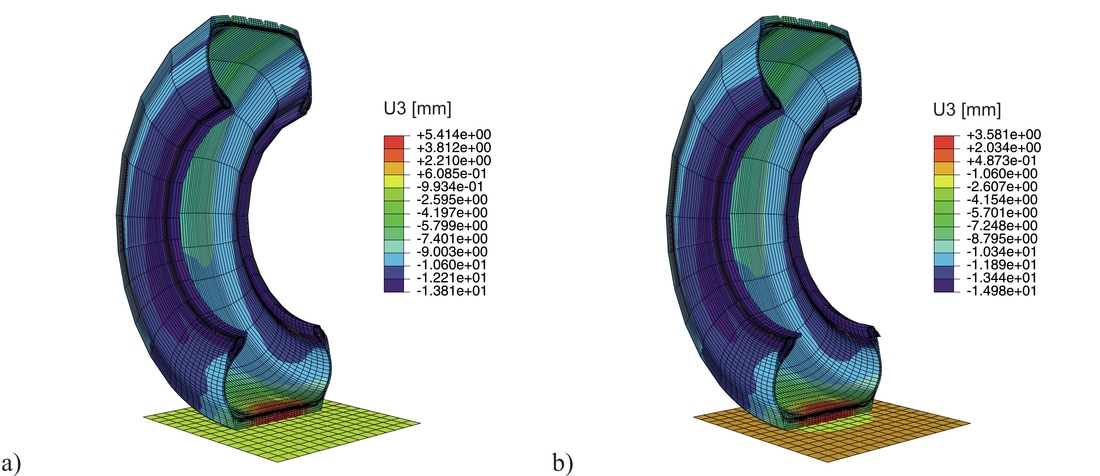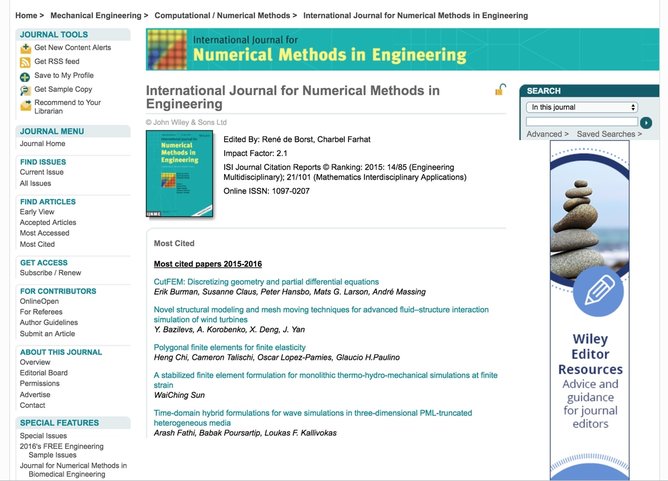|
A hierarchical sequential ALE poromechanics model for tire-soil-water interaction on fluid-infiltrated roads
Authors: Ines Wollny, WaiChing Sun, Michael Kaliske This paper introduces a hierarchical sequential arbitrary Lagrangian-Eulerian (ALE) model for predicting the tire-soil-water interaction at finite deformation. Using the ALE framework, the interaction between a rolling pneumatic tire and the fluid infiltrated soil underneath will be captured numerically. The road is assumed to be a fully saturated two-phase porous medium. The constitutive response of the tire and the solid skeleton of the porous medium are idealized as hyperelastic. Meanwhile, the interaction between tire, soil and water will be simulated via a hierarchical operator-split algorithm. A salient feature of the proposed framework is the steady state rolling framework. While the finite element mesh of the soil is fixed to a reference frame and moves with the tire, the solid and fluid constituents of the soil are flowing through the mesh in the ALE model according to the rolling speed of the tire. This treatment leads to an elegant and computationally efficient formulation to investigate the tire-soil-water interaction both close to the contact and in the far field. The presented ALE model for tire-soil-water interaction provides the essential basis for future applications e.g. to a path-dependent frictional-cohesive response of the consolidating soil and unsaturated soil, respectively. [URL]
0 Comments
Our paper "A stabilized finite element formulation for monolithic thermo-hydro-mechanical simulations at finite strain" published in IJNME at 2015 is the top 5 most cited papers from 2015 to 2016. The paper can be downloaded via the Wiley Online Library [URL]. Dates and Location: August 29-31, Copenhagen/Lyngby, Denmark Webpage: http://www.conferencemanager.dk/mcacm Overview and Objectives: Complex materials play an essential role in many applications, ranging from turbine blades, car chassis, computer and cell phone cases, battery systems, stretchable and wearable electronics, to biomedical applications. Those materials often operate and must maintain their high performance in harsh environments. The advancement of computationalmethods at multiple scales opens new possibilities for the design of such complex materials and the optimization of their intrinsic properties under extreme events. The bridging of different length and time scales though still represents an area of active research with many unresolved challenges. For example, material degradation is considered as a typical multiscale process, controlled by nanoscale defects, highly affecting the macroscopic material response. The confirmed presenters include Jose E. Andrade (Caltech), Ronaldo I. Borja (Stanford), JS Chen (UC San Diego), William Curtin (EPFL), Jacob Fish (Columbia), Somnath Ghosh (Johns Hopkins), Ellen Kuhl (Stanford), Lars P. Mikkelsen (TU Denmark ), Christian Frithiof Niordson (TU Denmark), Stefanie Reese (RWTH Aachen), Siegfried Schmauder (Stuttgart), Jörg Schröder (Universität Duisburg-Essen), Mads Peter Sørensen (TU Denmark) and others. Symposium Topics include but are not limited to • Multiscale modeling of materials • Multiphysics modeling of materials • Computational materials science • Micromechanics of materials • Scale bridging and homogenization • Materials under extreme environments • Hierarchical materials • Nanomaterials • Biological and natural materials • Geomaterials |
Group NewsNews about Computational Poromechanics lab at Columbia University. Categories
All
Archives
July 2023
|



 RSS Feed
RSS Feed